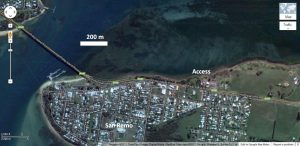
This is not the most convenient site because parking is difficult, the beach is not accessible at high tide, and the rocks are highly altered and slippery when wet. Drive to San Remo over the Phillip Island Bridge and find a place to park near San Remo Parade. Access the beach from a large grassy area opposite the Catholic Church. There are wooden stairs at the east end of this area. Do not try to climb down the steep cliff. When the tide is suitable you can walk around the beach to the east for a kilometre or so and return (2 kilometres return ~1 hour).
The northern coast of the San Remo Peninsula is a high coast formed in basalts of the Older Volcanics. Along the foreshore the basalt lava has been eroded away to expose the underlying sandstone sediments (such exposed older rocks are called ‘inliers’). When you check your geological map you can see that these sediments are part of the Strzelecki Group.
There are freshly broken basalt columns piled around the bluff adjacent to the bottom of the stairs. This is an artificial deposit, no doubt placed there to stop erosion, but it gives you a chance to see the mineral structure of fresh basalt. A wide, gently sloping platform runs along the shore, where you may be able to see exposures of the contact between the sandstone deposits and the overlying Older Volcanics at several places when the tide is low. The sediments include beds of grit derived from erosion of the Woolamai granite. Both the sandstone and basalt have been extensively altered making it difficult to identify the different rocks.
A layer of pebbles and cobbles covers most of this platform, and accumulations of pebbles and sand lie above high water mark at the base of most of the bluffs.Pebbles also lie above reach of wave action (1.5 metres) in the valley of a small creek. This suggests that the sea level in the area was higher in the past.
Significance
This site shows the relationship between the Strzelecki Group and the overlying basalt. It illustrates the involvement of water in the deposition and erosion of the various rock units. It illustrates the relative timing of the deposits.
Guide available as a booklet
This entry is taken from the geological excursion guide for Phillip Island. The complete guide is available as a booklet on creation.com Aussie store.